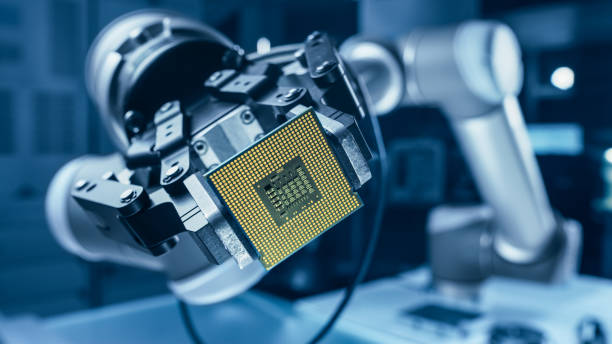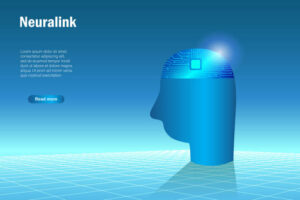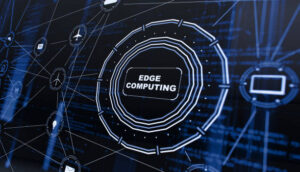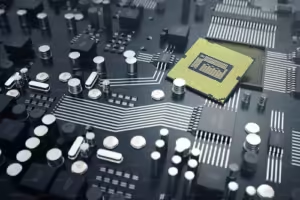
Modern High Tech Authentic Robot Arm Holding Contemporary Super Computer Processor. Industrial Robotic Manipulator End Effector Holding CPU Chip
These are new technologies that will forever revolutionize the world, but not in the manner you may think. Below are 7 emerging technologies that will forever revolutionize the world.
Artificial Genereal Intelligence

Artificial general intelligence Unlike limited artificial intelligence (AI), which is created for certain tasks, artificial general intelligence (AGI) refers to the idea of a machine that can comprehend, learn, and use its intelligence to solve any problem, much like a human person. AGI would be able to perform a variety of cognitive activities and independently adjust to changing circumstances.
Prominent institutions like Google Deep Mind and open Ai are making tremendous progress in the field of artificial intelligence research. Deep learning and neural networks, which imitate the structure and functionality of the human brain, are one method.
Scientists are attempting to extend these models to manage increasingly intricate abstract tasks that surpass pattern identification and data processing.
Another fascinating advancement is in the area of reinforcement learning, where AI programs are trained to make judgments through trial and error and are rewarded for successful solutions. It is believed that this strategy could lead to the development of more AI’s general problem-solving abilities
examining the future The development of artificial general intelligence (AGI) may have far-reaching effects if it were possible to accomplish a variety of activities, such as decision-making, sophisticated scientific research, and medical diagnosis.
We might eventually reach a point where artificial general intelligence (AGI) can perform any task involving computers. In some cases, it would even be able to outsmart humans, which would lead to advancements in a variety of fields.
Additionally, AGI might result in the creation of more adaptable and perceptive personal assistants that are able to recognize and cater to a variety of human requirements and preferences.
Artificial general intelligence (AGI) has the potential to create superintelligent artificial intelligence systems (AIS) that are capable of surpassing human intelligence by millions or even thousands of times. AGI in the industry could automate complex tasks, resulting in significant efficiency gains over time.
Make sure to read this article through to the end for more information about Quantum Computing humanoid robots. Advanced AI systems like these have the potential to generate revolutionary technologies and transform society in ways that are currently difficult to fully fathom. AI brain-computer interactions that are generative the internet of things
Crisper Gene Editing

Significant progress has been made in the field of biotechnology with the innovative technique of gene editing, especially with the advent of sharper C 9 technology.
The most common method of gene editing involves carefully changing a cell’s or organism’s DNA. Crisper C9 The process of gene editing works similarly to molecular scissors. Scientists can effectively modify the genetic code by removing, adding, or replacing certain genetic sequences by using a guide RNA to identify the precise DNA sequence to be edited and the C 9 enzyme to cut the DNA at that site.
One of the most fascinating recent developments in gene editing is its use in medical research and therapy. Researchers are able to treat genetic disorders in humans, such as muscular dystrophy and sickle cell anemia, by using Crisper to correct genetic defects in animal models.
Utilizing gene editing to alter immune cells to more effectively target and destroy cancer cells is another noteworthy advancement in the field of cancer research.
Considering the future Gene editing may develop to bring forth even more revolutionary advancements in agriculture and health care. Gene editing is frequently used to fix genetic flaws in human embryos, possibly averting inherited illnesses Parents may even be able to choose specific physical characteristics for their offspring, such as height, eye color, and intellect. These attributes could benefit the children in many areas of life and raise moral concerns about the effects of such decisions on society.
Furthermore, treatments tailored to a patient’s genetic profile, or personalized medicine, may eventually be accepted as normal procedure in healthcare, completely changing the way we provide medical care.
In agriculture, the production of crops with higher nutritional yields could result from gene editing. Increased yield and resilience to pests and environmental challenges In order to solve the issues with food security brought on by an increasing global population and shifting climatic circumstances, this may be essential.
Also Read: 25 HIGHER LEVEL TECHNOLOGICAL DEVICES
Quantum Computing

One of the most fascinating and quickly developing areas of technology is quantum computing. Unlike classical computing, which employs bits as the fundamental unit of information represented as either zero or one, quantum computing uses quantum bits, or cubits.
Because of the special ability of cubits to exist in multiple states simultaneously, namely superposition and entanglement, quantum computers are able to process a large number of possibilities at once, potentially providing a significant increase in computational power for specific tasks.
The achievement of quantum supremacy by Google is one of the most important recent developments in quantum computing. Quantum supremacy is the capacity of a quantum computer to do a calculation that is virtually impossible for a classical computer.
The quantum computer developed by Google In 200 seconds, Sycamore completed a calculation that would have taken thousands of years for the most powerful supercomputer in the world to accomplish.
An other noteworthy accomplishment is the augmentation of computing capacity of quantum computers by adding more cubits to their structure. With its constant record-breaking efforts to create the fastest quantum computers in the world, IBM is a major player in the quantum computing space.
Glancing ahead, this has led to the development of quantum resistant cryptography in drug discovery and material science. Quantum computing has the potential to have a significant impact on many fields, including cryptography, where quantum computers could potentially break many of the cryptographic systems currently in use.
High-accuracy simulations of molecular and quantum mechanical systems using quantum computers have the potential to accelerate the creation of novel medications and materials. The application of quantum computing to the resolution of challenging optimization issues, with implications for artificial intelligence, finance, and logistics, is another fascinating development.
Large data sets could be analyzed by quantum computers more quickly than by classical computers, which could lead to new discoveries and developments in data analysis and machine learning. However, there are still many obstacles to overcome, such as enhancing cubit stability and growing the number of cubits while controlling errors.
When these issues are resolved, quantum computing may go from being a tool mostly used in research to becoming a widely adopted technology that has the ability to resolve some of the trickiest issues facing science and business.
Neuralink and Brain Computer Interface

Some of the most innovative developments in the nexus of neuroscience and technology are represented by neuralink and other brain computer interfaces. The ambitious goal of neuralink, in particular, has drawn attention: it aims to create a high-bandwidth, minimally intrusive interface that directly connects computers to human brains.
The fundamental concept involves implanting incredibly fine threads—much thinner than a human hair—into the brain to monitor and record cell activity.
These threads are attached to an external device that processes and translates neural signals from the brain into computer-understandable commands. The current focus of neuralink and related brain-computer interface technologies is primarily medical, with the goal of assisting patients suffering from neurological disorders or paralysis.
For example, brain-computer interfaces provide a new degree of independence by allowing people to operate computer cursors or prosthetic limbs with just their thoughts.
Research on brain-computer interfaces to treat neurological diseases like epilepsy and Parkinson’s disease as well as restore vision, hearing, and other sensory abilities is currently ongoing.
Gazing ahead One area of research that might be greatly expanded by brain computer interfaces like Neuralink is the enhancement of human cognition, such as memory or processing speed.
In the field of leisure and gaming, brain computer interfaces may also open up more direct channels of connection, enabling people to telepathically share ideas or experiences. Brain-computer interfaces have the potential to provide completely immersive virtual reality experiences in which users can manipulate their surroundings and engage with digital information by thinking.
The application of brain computer interfaces in education and skill development is another fascinating possibility. These devices may speed up learning processes by enabling users to download knowledge straight into their brains in a manner similar to how computers download software.
We might perhaps enhance our mental capabilities to previously unheard-of heights by fusing our thoughts with artificial general and superintelligences.
Humanoid Robots

The capabilities of these machines are being pushed by recent developments in humanoid robotics, which will make them more interactive, adaptable, and human-like.
The mechanical architecture, sensory inputs, and cognitive processing capabilities of humanoid robots—which are meant to replicate and emulate the structure and behavior of humans—have significantly improved. Their balance and mobility are among the main improvements.
Modern humanoid robots can traverse a variety of terrains and even carry out actions like backflips and stair climbing because to a mix of sensors, actuators, and sophisticated algorithms that create a humanlike gate and balance. For the foreseeable future, Boston Dynamics and Tesla are anticipated to remain the two leading companies in the field of sophisticated robotics.
Humanoid robots can now interact with humans in more natural and intuitive ways because to advancements in artificial intelligence and machine learning. These robots can recognize faces, understand voice, and obey verbal directions.
In the future, humanoid robots may develop to play increasingly important roles in a variety of health care domains. For example, they could help with patient care, rehabilitation, and surgery, carrying out tasks with accuracy and consistency. In disaster response, humanoid robots might navigate hazardous environments and carry out search and rescue operations in situations where it would be too dangerous for humans. Sophia and Ameca stand out as two of the most well-known robots with these capabilities.
Furthermore, as robotics and artificial intelligence (AI) technology develops, we may witness the rise of humanoid robots in daily life, helping in offices, schools, and homes. These robots may be elderly people’s companions, young students’ teachers, or office assistants.
Generative AI

Recent years have seen remarkable advancements in generative AI, a branch of artificial intelligence focused on producing new content. One of the most notable developments is in the area of natural language processing, as demonstrated by large language models developed by open AI. These models can produce text that is human-like, enabling applications ranging from writing assistance to producing entire articles.
AI systems like Mid Journey, which can produce realistic images and artwork from written descriptions, represent another noteworthy advancement in the field of image generation and modification.
The technology producing AI-generated movies is developing quickly and has the potential to have a big impact on our daily lives. Generative AI works by using big data sets for training purposes in order to identify patterns.
Styles and structures: for text, this entails studying a large corpus of written material; for images, this entails examining a large number of photographs or artwork samples.
These artificial intelligence models can detect and reproduce complicated patterns and styles, making their outputs more and more comparable to content written by humans. They do this by using sophisticated algorithms, frequently based on neural networks.
examining the potential generative The subject of text generation is predicted to experience substantial advancements in AI. In the future, AI may be able to produce sophisticated artistic works like scripts or novels, possibly in collaboration with human authors, in addition to factual content.
In a future where artificial intelligence (AI) can create customized films in a variety of genres, you could, for example, ask an AI to create a two-hour film set in the Matrix Universe, directed by Christopher Nolan. A few hours of pre-rendering would then allow you to watch this specially created film on your television.
The use of generative AI to create personalized content across industries is another interesting possibility. For example, in education, AI may provide learning materials that are tailored to each student’s learning preferences and pace.
It could be used to produce virtual reality environments or customized gaming experiences for amusement. Consider the prospect of creating your own Grand Theft Auto game that takes place a century from now.
Furthermore, generative AI may be very helpful in research and development, helping to construct new scientific models, conduct tests, and generate hypotheses. Its capacity to process enormous volumes of data and produce fresh insights may quicken innovation in a number of industries.
Starlink Satellites and Internet

SpaceX is building the Starlink satellite internet constellation, which will significantly improve worldwide internet connectivity. The project’s goal is to offer high-speed internet access everywhere, especially in underserved and distant places.
Unlike traditional geostationary satellites, which are positioned much farther from Earth, starlink satellites are closer, lowering latency and boosting the speed of data transmission. This is where starlink’s current advancements lie.
Users of the Starlink network receive a kit that consists of a small satellite dish, also known as a “dishy,” and a Wi-Fi router. The dish communicates with the overhead satellites that relay internet signals to and from the ground. The Starlink network operates by deploying a constellation of small satellites in low earth orbit. These satellites work in conjunction with ground transceivers.
Laser lines are used to connect this constellation of satellites, providing a steady and uninterrupted internet connection.
Looking into how starlinks might develop in the future, one possible development is the satellite network’s expansion to provide even more global coverage, including in polar regions and other difficult-to-reach areas. This could result in truly global internet connectivity. bridging the digital divide and providing previously unconnected populations with internet access
The integration of Starlink with other SpaceX Ventures, such as Mars colonization missions, is an exciting prospect as well. Starlink could offer the interplanetary internet’s communication infrastructure, facilitating data transmission between Earth and Mars, which would be essential for the success of long-term space missions and colonization efforts.
Additionally, as the technology develops, we may witness increases in latency and data speeds that make satellite internet on par with or even better than traditional broadband services. This could result in a change in how people access the internet, with satellite internet emerging as the eighth most popular option.






